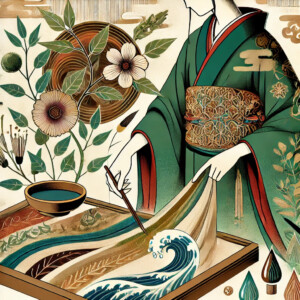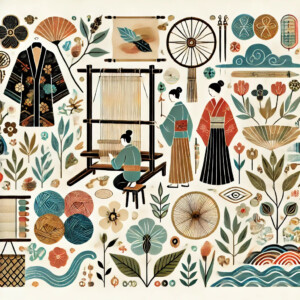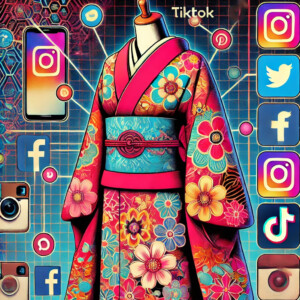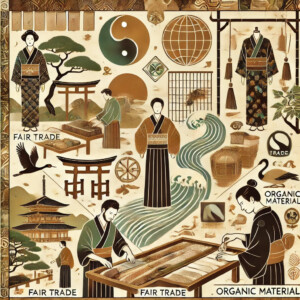Introduction
In an era where fashion trends shift rapidly, a fascinating movement is emerging—a global revival and reinterpretation of traditional folk costumes, particularly the Japanese kimono. This article delves into how these timeless garments are not just making a comeback but are being transformed into contemporary fashion statements. We will explore the fusion of traditional and modern elements, the influence of global perspectives, the intersection of sustainability, and the future of these iconic garments in the global fashion scene.
The Evolution of the Kimono: A New Wave
From Tradition to Modernity
The kimono, a symbol of Japanese culture, has a history that spans over a thousand years. Traditionally worn on special occasions, the kimono has always been associated with elegance, formality, and a deep respect for Japanese customs. However, in recent years, there has been a noticeable shift. The kimono is no longer confined to ceremonial use but is being embraced as a canvas for modern expression.
Japanese designers are reimagining the kimono, infusing it with contemporary aesthetics while maintaining its traditional essence. This evolution is partly driven by a desire to make the kimono more accessible and appealing to younger generations, who are looking for ways to connect with their cultural heritage without compromising their modern lifestyles.

Innovative Kimono Designs
Today’s kimono designs reflect a blend of tradition and innovation. Designers are experimenting with new fabrics, cuts, and patterns that challenge conventional norms. For instance, some modern kimonos feature asymmetrical hems, unconventional sleeve lengths, and even zippers—elements unheard of in traditional kimono design.
One of the most notable trends is the fusion of the kimono with Western fashion. Designers are incorporating elements such as leather, denim, and even streetwear-inspired details into their kimono collections. This fusion has created a unique style that resonates with both traditionalists and modern fashion enthusiasts.
Another trend is the use of non-traditional fabrics. While silk remains the fabric of choice for formal kimonos, modern iterations are being made from a variety of materials, including cotton, wool, and even synthetic blends. These fabrics not only make the kimono more versatile and suitable for everyday wear but also allow for greater experimentation with colors and textures.
Designers like Jotaro Saito and Hiroko Takahashi are at the forefront of this movement, creating kimonos that are bold, contemporary, and unmistakably Japanese. Saito, for example, is known for his avant-garde designs that incorporate digital prints and vibrant colors, while Takahashi focuses on minimalist aesthetics with a modern twist.
Global Perspectives: How Folk Costumes Are Evolving Worldwide
The Renaissance of Folk Costumes

The resurgence of the kimono is not an isolated phenomenon. Around the world, traditional folk costumes are experiencing a renaissance, as people seek to reconnect with their cultural roots in an increasingly globalized world. This trend is particularly evident in countries with rich textile traditions, such as India, Africa, and Mexico.
In India, the sari—a traditional garment worn by women—has seen a revival in recent years. Designers are modernizing the sari by introducing new draping styles, using contemporary fabrics, and adding embellishments that appeal to the modern woman. The sari is now being worn not just for special occasions but also as everyday wear, with women pairing it with Western-style blouses and accessories.
In Africa, the dashiki—a colorful garment with a loose-fitting silhouette—has become a symbol of pride and identity. Originally worn by men, the dashiki has been embraced by both men and women in contemporary fashion. Designers are experimenting with bold prints, vibrant colors, and modern cuts, making the dashiki a popular choice for both casual and formal wear.
Mexico’s huipil, a traditional garment worn by indigenous women, has also undergone a transformation. Once considered a symbol of indigenous identity, the huipil is now being incorporated into modern fashion, with designers creating contemporary versions that appeal to a broader audience. These modern huipils often feature innovative embroidery techniques, a mix of traditional and contemporary patterns, and a variety of fabrics that make them suitable for different occasions.
Cross-Cultural Influences in Fashion
As traditional costumes from different cultures gain popularity, cross-cultural influences are becoming increasingly evident in fashion. Designers are blending elements from various folk costumes to create garments that are truly global in nature. This fusion not only highlights the beauty of cultural diversity but also challenges the boundaries of traditional fashion.
One example of this cross-cultural influence is the kimono-inspired designs seen in international fashion shows. Designers from around the world are incorporating kimono elements into their collections, such as the wide sleeves, obi belts, and wrap-around styles. These designs often blend the kimono with other traditional garments, such as the Indian sari or the African kaftan, creating a unique and eclectic fashion statement.
In addition to designers, fashion brands are also embracing this trend. High-end brands like Gucci and Dior have incorporated traditional elements from various cultures into their collections, showcasing a blend of East and West, old and new. These designs have not only gained popularity on the runway but have also resonated with a global audience, who are increasingly looking for fashion that reflects their multicultural identities.
Social media platforms like Instagram and TikTok have played a significant role in popularizing these cross-cultural trends. Fashion influencers and enthusiasts from around the world are sharing their interpretations of traditional costumes, often mixing and matching elements from different cultures. This has created a vibrant and dynamic fashion scene where traditional garments are celebrated and reimagined in countless ways.

The Intersection of Tradition and Sustainability
Sustainable Fashion and Traditional Textiles
In recent years, sustainability has become a central theme in the fashion industry, and traditional textiles and garments are playing a significant role in this movement. The kimono, with its deep cultural roots and emphasis on craftsmanship, naturally aligns with the principles of sustainable fashion. Many modern designers are turning to traditional methods of production, which are often more sustainable and environmentally friendly than modern industrial processes.
For example, the use of organic dyes, handwoven fabrics, and slow fashion techniques are being reintroduced in kimono production. These practices not only reduce the environmental impact but also revive age-old skills that have been passed down through generations. This return to traditional craftsmanship is a response to the fast fashion industry, which is often criticized for its negative impact on both the environment and the workers involved in garment production.
The concept of “mottainai,” a Japanese term that expresses regret over waste, is being integrated into modern kimono design. Designers are finding creative ways to repurpose vintage kimonos, turning them into new garments, accessories, or home decor items. This approach not only honors the original craftsmanship but also promotes a circular economy within the fashion industry.
Ethical Production and Cultural Respect
As the kimono and other traditional garments gain popularity in global fashion, the issue of cultural appropriation has become a topic of discussion. While it’s exciting to see traditional costumes being embraced by a wider audience, it’s crucial to ensure that these garments are produced and worn with respect for their cultural significance.
Ethical production is key to maintaining the integrity of traditional garments. This involves collaborating with local artisans and communities who have a deep understanding of the cultural and historical context of these garments. By involving these communities in the design and production process, designers can create garments that are not only beautiful but also culturally authentic.

For instance, some designers are working directly with Japanese artisans to create kimonos that stay true to traditional techniques while incorporating modern elements. This collaboration ensures that the garments reflect the true essence of the kimono, while also providing economic support to the artisans who are keeping these traditions alive.
Moreover, educational initiatives are being launched to inform consumers about the cultural significance of the garments they purchase. Brands and designers are using their platforms to share stories about the history and meaning behind traditional costumes, encouraging consumers to appreciate and respect the cultural heritage they represent.
The Future of Kimono and Folk Costumes in Global Fashion
Predictions for Upcoming Trends
As we look to the future, the kimono and other traditional folk costumes are likely to continue their evolution within the global fashion landscape. One of the key trends we can expect to see is the increasing use of technology in the design and production of these garments.
Advancements in technology, such as 3D printing and AI-assisted design, are opening up new possibilities for reimagining traditional garments. For instance, designers are experimenting with 3D-printed accessories that complement traditional costumes, such as obi belts and intricate jewelry that can be customized to individual preferences. AI is also being used to analyze historical patterns and suggest innovative ways to incorporate them into modern designs.
Another trend to watch is the rise of “digital fashion,” where traditional garments are being recreated in virtual spaces. Digital fashion allows consumers to experiment with different styles and combinations without the need for physical garments. This trend is particularly popular among younger generations who are comfortable with technology and interested in sustainable fashion solutions.
The fusion of traditional and modern elements will likely become even more pronounced, as designers continue to explore the boundaries of what traditional garments can be. We may see more collaborations between designers from different cultural backgrounds, resulting in garments that blend elements from multiple traditions into a cohesive and innovative fashion statement.
The Role of Social Media in Popularizing Traditional Costumes

Social media will undoubtedly play a crucial role in shaping the future of traditional costumes in global fashion. Platforms like Instagram, TikTok, and Pinterest are already driving trends and influencing consumer behavior, and this trend is only expected to grow.
Fashion influencers who specialize in traditional costumes are gaining significant followings, sharing their unique interpretations of garments like the kimono with a global audience. These influencers often blend traditional and modern elements in their outfits, inspiring others to do the same. As a result, traditional garments are becoming more accessible and appealing to younger generations who may not have previously considered wearing them.
Hashtags like #KimonoFashion, #TraditionalWear, and #CulturalFashion are helping to build online communities where people can share their love for traditional garments. These communities provide a space for cultural exchange, where people can learn about the history and significance of different garments, as well as discover new ways to incorporate them into their everyday wardrobes.
Moreover, social media platforms are facilitating the rise of small, independent designers who specialize in traditional garments. These designers can reach a global audience with minimal marketing costs, allowing them to showcase their work and connect with consumers who appreciate the artistry and craftsmanship behind traditional clothing.
Conclusion
The resurgence of the kimono and other traditional folk costumes in global fashion is a testament to the enduring appeal of cultural heritage. As these garments continue to evolve, they are becoming symbols of both tradition and innovation, blending the old with the new in ways that resonate with a modern audience.
The future of traditional garments in fashion is bright, with new trends, technologies, and social media platforms driving their continued popularity. By embracing both tradition and modernity, designers, artisans, and consumers alike are ensuring that these garments remain relevant and cherished for generations to come.

As we move forward, it is essential to maintain a balance between honoring cultural heritage and embracing innovation. By doing so, we can create a fashion landscape that is not only beautiful and diverse but also respectful and sustainable.

Comment